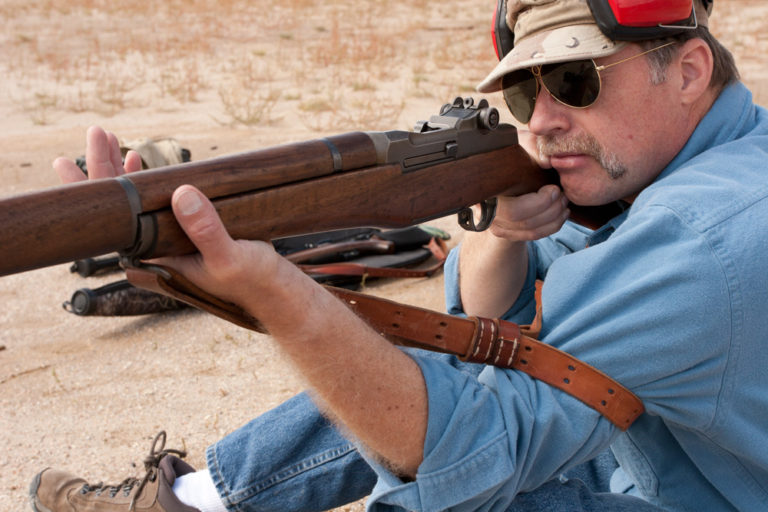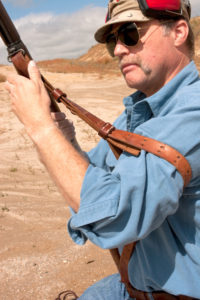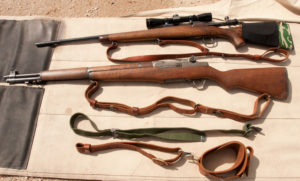
One of the most useful rifle shooting aids is also one of the most neglected. That is the use of the loop sling. The support and steadiness it provides, when properly used, is enormous.

Contrary to what you may have read before, the loop sling does not “tie the rifle to your shoulder,” or to your arm for that matter.
What it does is to replace your support arm bicep muscle in holding up the weight of the rifle, not only taking one more trembling muscle out of the picture, but also preventing the support arm elbow joint angle from opening up and lowering the rifle, and even helping support the weight of the upper body in certain positions.
While proper use of the shooting loop sling was long a staple of military training and was well known amongst hunters, the military started getting away from teaching it in the years after the Korean War.
As a result, the knowledge of how to use this handy technique has all but disappeared from both the military and civilian worlds of riflery.
This is a shame, as a properly set-up sling is a major aid to gaining a steady position. Col. Cooper’s observations, if I recall correctly, were that the shooting loop sling is useful in perhaps 60% of rifle hunting situations, and increases your steadiness by about 30%. I personally think he was being conservative.
The best use of the shooting loop sling requires the support arm elbow (left elbow if you shoot righty) to be rested on a support. This can be a log, car hood (if legal for hunting in your state – it’s not in mine!), the ground (in prone), or your own leg (kneeling, squatting, or sitting).

When your elbow is hanging in the air you still have to use your support-side shoulder (front deltoid) muscle to hold everything up, so much of the steadiness a loop sling affords is wasted, since the only muscle it replaces is the bicep. If your elbow is not supported you can’t truly relax your support arm from shoulder to fingertips.
If the situation calls for – and allows – the taking of any position or rest where the support arm elbow is planted on something solid, the shooting sling is the quickest, simplest, and least cumbersome steadiness aid there is.
Got a bipod? Fine. How much weight does it add to your rifle, and how long does it take to deploy it and adjust its length properly?
Carrying shooting sticks? Okay, how do you like carrying them all day? How much movement do you make setting them up properly?
Granted, if your hunting style is to sit down, set up, and not move all day, the aforementioned shooting aids will work quite well. But if handiness and speed of deployment count, it’s hard to beat the right kind of shooting sling. With the modern fast-acquisition loop sling you can loop up in it while moving into position.
A proper shooting loop sling (as distinct from just a carry strap), used in the right situation, supports the weight of the rifle and allows you to relax into your position, thus freeing your muscles of the strain of holding up the rifle and recovering it on target after every shot. The rested elbow relieves your shoulder muscles of the task of holding up both arm and rifle.
Once your shoulder is no longer doing the work, the task of holding up the rifle is left to your support arm bicep, which has to keep tense to keep the weight of the rifle from sagging downwards. Now, wouldn’t it be nice to be able to substitute yet another stable support for a muscle that can tire and tremble?

The shooting sling performs this task very nicely by forming a loop, which wraps around the back of your upper support arm (the higher the better) and the front of your wrist.
This loop captures and surrounds your entire arm, from the armpit to wrist, preventing the elbow joint from moving in a more open direction. Viewed from the side, you have a point-downwards rigid triangle formed by the sling horizontal across the top, and your forearm and upper arm forming the other two sides.
Gravity, attempting to pull the rifle downwards, has a tendency to work against your bicep muscle, making your support arm want to open up its angle through movement of the elbow joint (if your support elbow is positioned directly under the rifle).
But the sling, by wrapping around both your support wrist and support upper arm, will start to tighten up if this happens.
Forward and downward motion of that wrist against the sling pulls the sling against the back of your upper arm, and once it tightens up it will prevent your support wrist from moving any further downward (where the weight of the rifle wants to push it). Your bones and the sling do all the work.
Editor's Note: This article is excerpted from the Gun Digest Shooter's Guide to Rifle Marksmanship.

Next Step: Get your FREE Printable Target Pack
Enhance your shooting precision with our 62 MOA Targets, perfect for rifles and handguns. Crafted in collaboration with Storm Tactical for accuracy and versatility.
Subscribe to the Gun Digest email newsletter and get your downloadable target pack sent straight to your inbox. Stay updated with the latest firearms info in the industry.

![Best Concealed Carry Guns In 2025 [Field Tested] Wilson Combat EDC X9S 1](https://gundigest.com/wp-content/uploads/Wilson-Combat-EDC-X9S-1-324x160.jpg)


![Best 9mm Carbine: Affordable PCCs [Tested] Ruger Carbine Shooting](https://gundigest.com/wp-content/uploads/Ruger-Carbine-Shooting-100x70.jpg)
![Best AR-15: Top Options Available Today [Field Tested] Harrington and Richardson PSA XM177E2 feature](https://gundigest.com/wp-content/uploads/Harrington-and-Richardson-PSA-XM177E2-feature-100x70.jpg)

Same we did it in the Marines.
Using the shooting stick or the shooting sling can both take a lot of time to set up in a hurry. The “hasty sling” method is much quicker to use by simply slipping and wrapping your arm around your carry sling providing you are not using the popular extra wide padded sling which is useless for this type of shooting.
Another option is to attach your shooting sling to your arm ahead of time. Let the sling simply hand down from your arm. Also you can buy a sling hook that lets you instantly attach the sling to the front sling swivel and lets you detach it instantly. They are available from places that cater to competition shooters and are very popular with them. Of course this leaves you without a carry sling because your sling is attached to our arm. I have even used two sling at once. One attached to the gun for carry with a quick detachable sling swivel up front and the other shooting sling attached to my arm ahead of time. Its not every ones cup of tea but it does work if you need your hands free from your gun while climbing up a tree or up the side of a mountain.
One of the best shooting competition slings ever made (no longer made after the death of the inventor) was the Mo’s double belt buckle sling. It had two belt buckles, one which was used to tighten the sling around the arm. When you got it tight the sling did not slip down as most other slings tend to due, even presently made competition slings. In desperation a friend of mine made one himself by buying the appropriate leather making tools and it turned out every bit as good as the original. Its a shame no one make this excellent sling anymore.
I really like this article, as it shows that slings are indeed on the decline. I would like to point out that the Marine Corps is still to this day using slings when teaching marksmanship. After nine years in the Corps, I cannot think of shooting any rifle without the use of a sling.
I recently purchased an M1 Garand from CMP, and I found that I really do need a sling with that rifle. I have placed an order for a nice leather sling like pictured above.
Thanks for the great article, and the information that I look forward to reading every day.
Ron Walsh